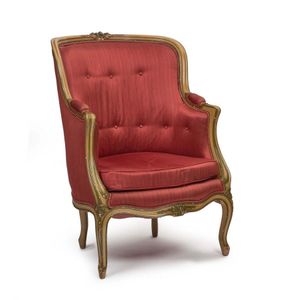Loetz Silver Overlay Iridescent Glass Vase
A Loetz silver overlay iridescent glass vase, circa 1900 the silver overlay formed as twining leafage over the iridescent blue green bulbous form 9 cm high
You must be a subscriber, and be logged in to view price and dealer details.
Subscribe Now to view actual auction price for this item
When you subscribe, you have the option of setting the currency in which to display prices to $Au, $US, $NZ or Stg.
This item has been sold, and the description, image and price are for reference purposes only.
- Circa - A Latin term meaning 'about', often used in the antique trade to give an approximate date for the piece, usually considered to be five years on either side of the circa year. Thus, circa 1900 means the piece was made about 1900, probably between 1895 and 1905. The expression is sometimes abbreviated to c.1900.
- Irridescent Glass - Iridescent glass has a shimmering or rainbow-like appearance due to the way it reflects light. It is created by applying a thin layer of metal oxides to the surface of the glass while it is still hot and malleable, which then creates an interference effect that produces a range of colours as the light reflects off the surface. The exact colours and patterns created by iridescent glass depend on the specific types of metal oxides used and the techniques used to apply them.
Iridescent glass was first developed in the late 19th century, and quickly became popular for use in decorative art glass and stained glass windows. Some of the most famous examples of iridescent glass were created by artists such as Louis Comfort Tiffany and his studio, who used it extensively in their distinctive lamps, vases, and other decorative objects. - Overlay Glass - Overlay glass is coloured glass that has been created by sandwiching two or more layers of different coloured glass together. The layers are fused together through a process of heating and melting in a glass furnace, and the resulting glass has a unique colour and depth that is not found in single-layered glasses.
The technique of overlaying glass has been used for centuries, and was particularly popular in the Venetian glass industry during the Renaissance. Different colours of glass were layered to create intricate designs, and then the layers were carved and etched to create intricate patterns and details.
This item has been included into following indexes:
Visually similar items

A pair of Louis XV painted and satin upholstered bergere, 20th century
Sold by
in
for
You can display prices in $Au, $US, $NZ or Stg.

A Chinese black lacquered opium bed. rectangular, with a carved apron and legs, 210 x 44 x 110 cm
Sold by
in
for
You can display prices in $Au, $US, $NZ or Stg.

A square ring by river Wilkes the wide band with brown gun-metal finish, mounted in sterling silver, circa 2002, width 90 mm, ring size X.
Sold by
in
for
You can display prices in $Au, $US, $NZ or Stg.

Mounted white kiwi in display box
Sold by
in
for
You can display prices in $Au, $US, $NZ or Stg.
